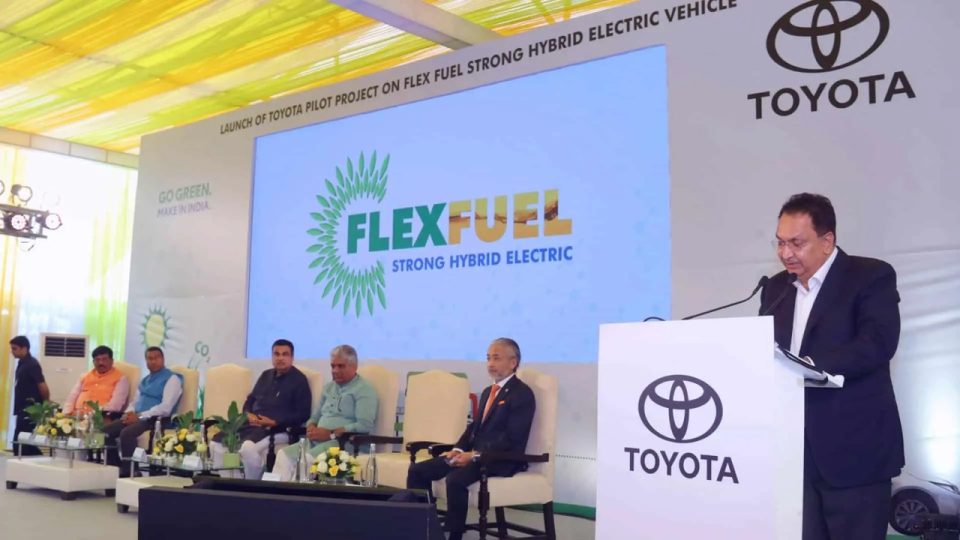While the world is debating the next alternative energy source to power cars, Toyota has launched its first pilot project in India, the Flexible Fuel Strong Hybrid Electric Vehicle (FFV-SHEV). New cars can use 100% ethanol.
The FFV-SHEV has a flexible combustion engine and electric powertrain. This setup extends the dual benefits of higher ethanol usage and better fuel efficiency, as it can run in E.V. mode for extended periods with the engine off.
In the long run, this appears to provide a solution to the much-discussed concern of finding an alternative medium to run the vehicle on.
While India has been rolling out initiatives for nearly every other alternative energy technology, reducing vehicle emissions has emerged as one of the country’s most pressing goals in the near term. The focus has shifted to endorsements for hydrogen and electric vehicles.
Indian Minister Nitin Gadkari has launched Toyota’s first flexible fuel hybrid electric vehicle (FFV-SHEV) pilot project. New cars can use 100% ethanol. Ethanol – perhaps the most popular alternative biofuel, a locally produced substance, has entered people’s fuel tanks. It is environmentally friendly and meets stricter emission standards.
Flexible fuels, or flex-fuels, have been in the spotlight after they emerged as an alternative, environmentally friendly fuel that could help combat rising fuel prices and pollution levels.
These are considered alternative fuels and combine regular gasoline and methanol/ethanol. Unlike CNG fuel systems, where gasoline and CNG are stored in separate tanks and used by the engine alone, the flex-fuel combination is stored in the same tank and used by the engine as a mixture.
Flex fuel engines have become popular in many countries, including Brazil, the USA, the E.U. and China. India is the fifth largest ethanol producer after the United States, Brazil, the European Union and China.
As of 2018, there were more than 21 million flex-fuel vehicles in the U.S., but Brazil was the largest market and leader in the segment, according to IHS Markit. Aside from an ethanol-compatible fuel system and different powertrain calibrations, flex-fuel vehicles are like traditional gasoline-only vehicles.
The ratio of ethanol to gasoline in flex-fuel can be adjusted, but the most used flex fuel uses 85% ethanol and 15% gasoline. Unlike gasoline, ethanol is not a by-product of crude oil. Rather, it is a complex derivative of biomass left over from agricultural raw materials such as corn, sugar cane, hemp (bhang), potatoes and rice.
Ethanol extracted from sugar cane juice; from molasses – a black viscous product extracted from refined sugar cane. These agricultural products are abundant in India, so the Indian government has made a concerted effort to promote ethanol as an alternative fuel option.
Ethanol has a cleaner burning quality than gasoline, which allows flex-fuel vehicles to leave less toxic fumes in the environment. Advanced technology is used to make flex-fuel engines, which also involve electronic sensors. These advancements allow vehicles to detect fuel mixtures and make any necessary adjustments. Using sustainably produced ethanol makes flex-fuel a green option.
According to an article in the Indian Express, the fuel system of a flex-fuel vehicle is identical to most of the components of a conventional pure-gas vehicle. Some special ethanol-compatible components need to accommodate the different chemical compositions and energy content of ethanol or methanol, such as modifications to fuel pumps and fuel injection systems. The ECM was also calibrated to accommodate the higher oxygen content in ethanol.
The most important benefit is that using an ethanol blend significantly reduces harmful pollutants such as carbon monoxide, sulphur and oxides of carbon and nitrogen. Another obvious benefit is that blending will help reduce oil imports for fuel vehicles.


 Signals, Powered By EquityPandit
Signals, Powered By EquityPandit

